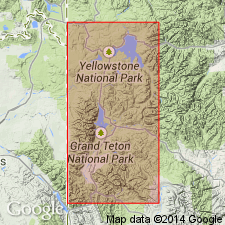
- Usage in publication:
-
- Crater Tuff Breccia Member
- Modifications:
-
- Named
- Dominant lithology:
-
- Tuff
- Breccia
- AAPG geologic province:
-
- Yellowstone province
Summary:
The Crater Tuff Breccia Member, here named, is the lower member of the Colter Formation in the area of Crater Mountain, Two Ocean Lake, and Emerald Lake, Teton County, Wyoming. Source area for the member is northwest of Pilgrim Mountain adjacent to the northern part of the Teton fault. Consists of andesitic, trachytic, and latitic tuff and ignimbrite, and is distinguished by its abundant tuff breccia and tuff, bright-green or drab-gray color, angular to subangular lithic clasts, and rare rounded quartz cobbles. Overlies unnamed pre-Colter rocks, Paleocene Pinyon Conglomerate, or Oligocene White River Formation; underlies the Pilgrim Conglomerate Member (new) of the Colter. Thickness is 500 m. Age is Miocene. Was deposited between 24 and 18 Ma during early (compressional) andesitic volcanism. Report includes measured sections, stratigraphic chart, chemical analyses, clast-size studies.
Type section (= lower part of Colter Formation type section): along East Pilgrim Creek, Two Ocean Lake 7.5-min quadrangle, Teton Co., WY (Yellowstone province). Named from Crater Mountain.
Source: US geologic names lexicon (USGS Bull. 1565, p. 79); supplemental information from GNU records (USGS DDS-6; Denver GNULEX).
For more information, please contact Nancy Stamm, Geologic Names Committee Secretary.
Asterisk (*) indicates published by U.S. Geological Survey authors.
"No current usage" (†) implies that a name has been abandoned or has fallen into disuse. Former usage and, if known, replacement name given in parentheses ( ).
Slash (/) indicates name conflicts with nomenclatural guidelines (CSN, 1933; ACSN, 1961, 1970; NACSN, 1983, 2005, 2021). May be explained within brackets ([ ]).

